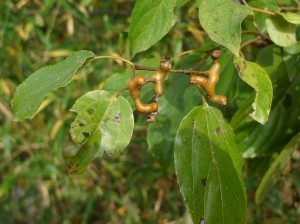Fuchsia Dunlop's Blog, page 4
January 18, 2014
Firecracker chicken – laziji 辣子鸡
 As 2014 is the Year of the Horse, perhaps I should be marking the Chinese New Year with a horse recipe (!) – but instead I‘ve put together one for that Chongqing classic, ‘Chicken with chillies’ (lazi ji 辣子鸡). You can read the full recipe on the Financial Times website here, along with a quick and easy version that does not require dismembering a poussin but uses chicken wings instead.
As 2014 is the Year of the Horse, perhaps I should be marking the Chinese New Year with a horse recipe (!) – but instead I‘ve put together one for that Chongqing classic, ‘Chicken with chillies’ (lazi ji 辣子鸡). You can read the full recipe on the Financial Times website here, along with a quick and easy version that does not require dismembering a poussin but uses chicken wings instead.
At first sight, this dish can appear terrifying to the uninitiated, because there are more chillies than pieces of chicken, a great red -silk-and-firecracker pile of them. But, as with that other notoriously chilli-laden dish ‘Water-boiled fish’ (shui zhu yu 水煮鱼), the spices are just there to lend their flavour to the cooking oil, and should not be eaten. Use your chopsticks to rummage out crisp morsels of chicken from among them. The fragments of skin will be the most delicious, and some of the little bones so crisp you can munch them.
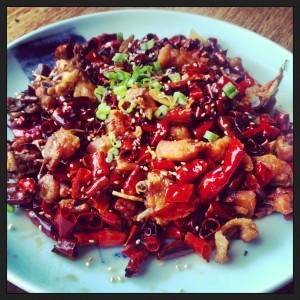 This recipe is a speciality of Geleshan (Gele Mountain) in Chongqing, that vast municipality that was until 1997 a district of Sichuan Province. There, they use young free-range chickens, which is why I recommend using a poussin if you can find one – these small birds can be cut into the dainty little pieces that will become sizzly crisp and fragrant in the deep-frying oil. If you can’t find poussin, used boned chicken thigh meat instead.
This recipe is a speciality of Geleshan (Gele Mountain) in Chongqing, that vast municipality that was until 1997 a district of Sichuan Province. There, they use young free-range chickens, which is why I recommend using a poussin if you can find one – these small birds can be cut into the dainty little pieces that will become sizzly crisp and fragrant in the deep-frying oil. If you can’t find poussin, used boned chicken thigh meat instead.
Please make sure you buy dried chillies that have a deep red colour but are not too hot: avoid those aggressive little bird’s eye chillies, and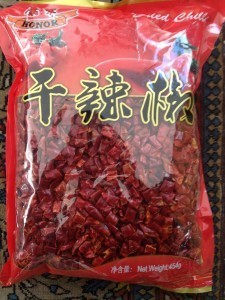 choose instead larger varieties like Sichuan facing heaven chillies, or the pointy chillies you can see in my photographs. (Mexican de Arbols are a reasonable substitute.) I bought the ones you can see in the pics from New Loon Moon in Gerrard Street, Chinatown, London. Conveniently, they had already been cut into sections and largely deseeded, which saved time in the kitchen.
choose instead larger varieties like Sichuan facing heaven chillies, or the pointy chillies you can see in my photographs. (Mexican de Arbols are a reasonable substitute.) I bought the ones you can see in the pics from New Loon Moon in Gerrard Street, Chinatown, London. Conveniently, they had already been cut into sections and largely deseeded, which saved time in the kitchen.
Serve the dish as part of a Chinese feast – ideally with some fresh, vibrant greens, a gentle broth to balance the fiery dryness of the chicken, plain white rice and any other dishes you fancy.
January 14, 2014
Hutong at the Shard (or Chinese food at the top of the world)
 Well, I was a total shard-sceptic, but now, having been inside the building for the first time, I have to admit I’ve been converted. A friend of mine is working in the kitchens of Hutong, the Chinese restaurant on the 33rd floor, and invited me to lunch – and what a view! What a feast! We dabbled in the dim sum menu: opalesque, translucent orbs filled with colourful morsels (‘crystal crab meat dumpings’); roast puff pastries stuffed with wagyu beef instead of the usual char siu pork; and pretty little bundles tinted with spinach juice, holding a mix of carrot and shiitake mushrooms. Judging by these, the dim sum here is exquisite and at least on a par with its closest London rival, the Royal China Club.
Well, I was a total shard-sceptic, but now, having been inside the building for the first time, I have to admit I’ve been converted. A friend of mine is working in the kitchens of Hutong, the Chinese restaurant on the 33rd floor, and invited me to lunch – and what a view! What a feast! We dabbled in the dim sum menu: opalesque, translucent orbs filled with colourful morsels (‘crystal crab meat dumpings’); roast puff pastries stuffed with wagyu beef instead of the usual char siu pork; and pretty little bundles tinted with spinach juice, holding a mix of carrot and shiitake mushrooms. Judging by these, the dim sum here is exquisite and at least on a par with its closest London rival, the Royal China Club.
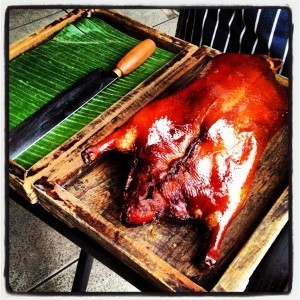
Peking duck
Most exciting for me was the Peking duck, carved tableside by a chef, and laid out prettily on a bamboo tray lined with banana leaf. (It’s not actually cooked in what looks like a Beijing wood-burning brick oven at the side of the restaurant but in the steel Peking Duck oven that stands next to it - presumably open fires are not encouraged on the 33rd floor of a skyscraper .) My only quibble was that the accompanying pancakes were not the traditional hand-rolled, floury pancakes that are lightly toasted on a griddle, but something more like a breakfast pancake, with a softer, wetter texture. But the quality of the duck itself was probably better than any I’ve had in Beijing, even at Da Dong: it was gorgeous, succulent and richly flavoured. And frankly, the combination of duck, sweet dark sauce, cucumber, scallion and pancake is pretty unbeatable, however you do it. I ate rather a lot of duck, as you might imagine, at least a quarter of it, without realising how many other dishes were coming…
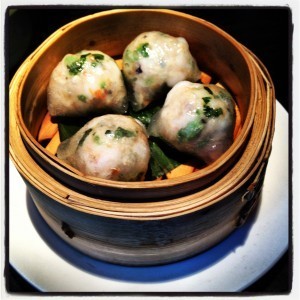
Crystal dumplings
The ‘crispy de-boned lamb ribs’ were expertly cooked and deeply lovely, though possibly not what you absolutely need after consuming a quarter of a roast duck (!); the prawns with salted duck egg yolk were excellent; and the stir-fried Chinese broccoli a welcome gust of vegetarian freshness. I was less keen on the crispy beef – it was a perfectly good rendition, but it’s one of those dishes, like sweet-and-sour pork, that I associate with set menus in more ordinary Cantonese restaurants.
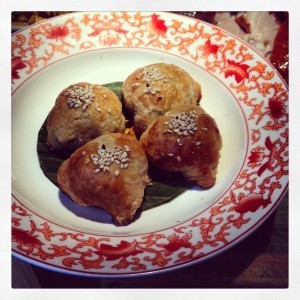
Wagyu beef pastries
Overall, the style of the food (though not the actual menu) is reminiscent of Hakkasan, in that it’s mainly aimed at Westerners, with an emphasis on crowd-pleasing, intensely flavoured deep-fried and roasted dishes, and perhaps fewer of the delicate soups, fresh vegetables, steamed dishes and unusual ingredients than you’d find in a more Chinese Chinese restaurant. The produce is plainly excellent, and there’s a Cantonese slant to many of the dishes.
 But the view! London unfolded in a romantic panorama that reminded me of those sweeping scenes of Paris in the film ‘Moulin Rouge’. We were there on a cold, misty day, and the city looked monochrome and almost Dickensian, with plumes of steam rising like smoke, the river a brown ribbon snaking into the distance, and St Paul’s cathedral standing steadfastly on the other side of the water. We sat by the window, gazing out over the spotlit table and the painterly colours of the food at this unforgettable sweep of London, sipping oolong tea and red wine, eating… As dusk fell, the twinkling lights scattered far below seemed magical.
But the view! London unfolded in a romantic panorama that reminded me of those sweeping scenes of Paris in the film ‘Moulin Rouge’. We were there on a cold, misty day, and the city looked monochrome and almost Dickensian, with plumes of steam rising like smoke, the river a brown ribbon snaking into the distance, and St Paul’s cathedral standing steadfastly on the other side of the water. We sat by the window, gazing out over the spotlit table and the painterly colours of the food at this unforgettable sweep of London, sipping oolong tea and red wine, eating… As dusk fell, the twinkling lights scattered far below seemed magical.
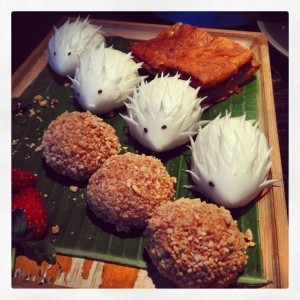
Hedgehog buns and other desserts
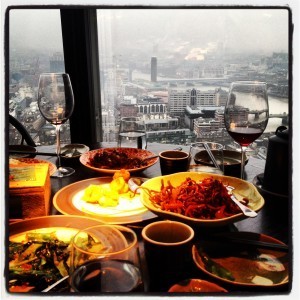 Fortunately I wasn’t paying the bill… but although I tend to avoid the glitzy Chinese places, in general preferring that my money is spent on good food rather than glamorous decor, and although I’ll normally always choose the more Chinese places over Chinese restaurant primarily aimed at Westerners, Ithink for Hutong I’ll make an exception. The staggering setting, the good food, the sense of occasion and the sheer thrill of looking down over London mean I’ll probably be back, even when I’m spending my own money!
Fortunately I wasn’t paying the bill… but although I tend to avoid the glitzy Chinese places, in general preferring that my money is spent on good food rather than glamorous decor, and although I’ll normally always choose the more Chinese places over Chinese restaurant primarily aimed at Westerners, Ithink for Hutong I’ll make an exception. The staggering setting, the good food, the sense of occasion and the sheer thrill of looking down over London mean I’ll probably be back, even when I’m spending my own money!
January 9, 2014
You turnip! Vegetable insults around the world
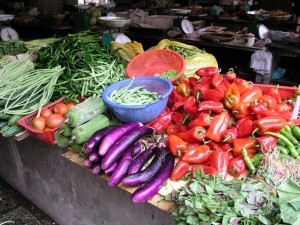
Which to choose, from such an embarrassment of possibilities?
In Zambia, an opposition politican has been charged with defamation for comparing the president to a potato. Speaking on the radio earlier this week, Frank Bwalya described president as ‘chumbu mushololwa’, an expression in the Bemba language which, according to the BBC website, refers to ‘a sweet potato that breaks when it is bent and is used to describe someone who does not listen to advice’. It found guilty, Mr Bwalya faces a prison sentence of up to five years.
Personally, I think I’d find it more insulting to be compared to a kohlrabi – not the world’s loveliest vegetable, even if it’s delicious. (A friend and I were wondering how many years you would get for that – perhaps even execution?)
This is not the first time that Zambia has seen controversy over vegetable-based insults. In 2002 the editor of an independent newspaper, Fred M’membe, was arrested for calling the president a ‘cabbage’: a slight also recognised in the English language (as is the more general ‘vegetable’).
In Chinese, it’s common to insult someone by calling them a ‘stupid melon’ (傻瓜 sha gua), and those seen as sell-outs to their ethnic heritage may be called ‘bananas’ – because a banana is ‘yellow on the outside, white on the inside’. In Communist societies in Europe, much worse was to be labelled a ‘radish’, because radishes are ‘red on the outside and white on the inside’, and therefore potentially counter-revolutionary. And a black person may be offended to be called a ‘coconut’ – ‘black on the outside, white on the inside’.
It would be interesting to hear about fruit and vegetable insults in other cultures and languages, if anyone knows any! And what would be the worst vegetable or fruit to be called?
January 3, 2014
Dinner at the Clove Club

Radical chicken's feet
There is only the slightest, most tenuous little Chinese excuse for writing about my recent dinner at the Clove Club on this blog, but it was such a fabulous meal that I’m going to anyway. My phone ran out of juice very quickly so I took almost no photos (which was actually a relief: Instagram is fun but can also be a self-imposed tyranny). We had the set menu, with a few extra tasters which were sent out by the kitchen.
The Chinese excuse lies in one of the extras, an ingenious little concoction of boned, deep-fried chicken’s feet, gently embracing a mushroom and chicken stuffing. This is the only time I’ve ever been served chicken’s feet in a non-Chinese restaurant, and these were divine: crisp, crunchy and totally unexpected. (Have any blog readers come across interesting chicken’s feet dishes outside the Chinese culinary world?)
In general, Isaac McHale’s cooking is a delightful mix of the warm and old-fashioned (with ingredients such as wood pigeon, greengages and peated barley) and the radical (those chicken’s feet; using the peated barley in a cake that had the gorgeous smokiness of whisky), and the dining room is simple and uncomplicated, without the fuss and circumstance that often accompanies food of this quality. The wines offered as pairing for the dishes were exciting and offbeat.
A few other highlights: slices of white truffle layered on scrambled eggs like autumn leaves; cornish sea bass in brown butter; the singing, whizzy lemoniness of a frothy cream dessert, with a tingly undercurrent of black pepper; the smouldering peatiness of that whisky cake. Altogether one of the most thrilling meals I’ve had in a long time, and extremely good value by London standards.
Apologies for the poor quality of the pic, which was taken in flickering candlelight.
January 2, 2014
President Xi Jinping’s steamed baozi
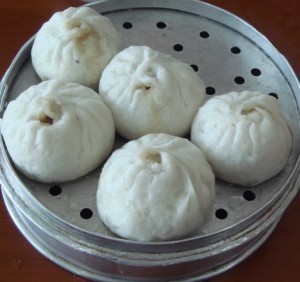
Baozi (library pic - not from Qing Feng)
Last week, Chinese president Xi Jinping caused a sensation after being photographed queueing up for a tray of steamed baozi at a Beijing snack shop, Qing Feng. According to the pics, he bought his own meal ticket, queued up with a tray, collected his pork buns, and then sat down among other customers to eat them. Chinese people have been amazed to hear of their paramount leader rubbing shoulders with the ‘Old Hundred Names’ commoners of Beijing. Some have reacted cynically, wondering if this could possibly be a cynical PR stunt (dreamed up perhaps after former US ambassador to China Gary Locke caused such a stir by buying his own coffee in Beijing), rather than a real glimpse into the hitherto unknown everyday life of Xi Jinping.
It is unusual for today’s Chinese leaders to fraternise with the public. On my most recent trip to China, one of my friends remarked on how leaders’ lives were an absolute mystery: ‘No one ever sees them. We don’t even know if they actually live in Zhongnanhai, the leadership compound, as they are said to. After all, no one ever sees them going in or out.’
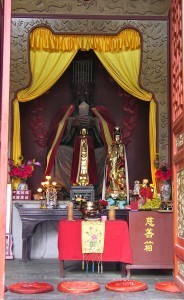 However, it has been a familiar trope for Communist Party dignitaries to drop on on famous Chinese restaurants. If you visit Huogongdian (the Fire Temple) in the centre of the Hunanese capital, Changsha, you can actually see the armchair in which Mao Zedong sat when he visited in April 1958, which has been preserved as an exhibit, cordoned off at the side of one of the private dining rooms. At Lao Sun’s yang rou pao mo (soaked flatbreads with mutton) restaurant in Xian, they have preserved the entire collection of dishes and implements used by various visiting politicians, including Mr Xi’s predecessor Hu Jintao, and put them on display in glass cabinets like holy relics. Many other restaurants I have visited, all over China, proudly display photographs of visiting politicians and generals, or calligraphic inscriptions in which they praise the food.
However, it has been a familiar trope for Communist Party dignitaries to drop on on famous Chinese restaurants. If you visit Huogongdian (the Fire Temple) in the centre of the Hunanese capital, Changsha, you can actually see the armchair in which Mao Zedong sat when he visited in April 1958, which has been preserved as an exhibit, cordoned off at the side of one of the private dining rooms. At Lao Sun’s yang rou pao mo (soaked flatbreads with mutton) restaurant in Xian, they have preserved the entire collection of dishes and implements used by various visiting politicians, including Mr Xi’s predecessor Hu Jintao, and put them on display in glass cabinets like holy relics. Many other restaurants I have visited, all over China, proudly display photographs of visiting politicians and generals, or calligraphic inscriptions in which they praise the food.
And although it might look as though Mr Xi was following the American example in being caught acting normally, his visit to Qing Feng also echoed an old Chinese tradition of emperors venturing out of their palaces to experience the life of the common people. There are countless stories, whether legendary or based in fact, of emperors sneaking out in disguise to eat and drink with their citizens. One of the best known is said to be the origin of that Cantonese habit of tapping fingers on the dim sum table in thanks when someone fills your cup with tea: the Qianlong Emperor, so the tale goes, visited a teahouse incognito, and when he poured tea for his servants they knew the usual kowtows demanded of them by palace etiquette would blow his cover, so they tapped their fingers on the table in a miniature form of prostration.
Such stories are an age-old means of demonstrating the concern of Chinese leaders for their subjects. Of course, when the Qing emperors mingled with the populace (if they actually did), there were no smartphones to record the occasion, or microblogging sites to spread the word. But courtiers with a keen eye for the emperor’s image made sure that word spread that this disguised stranger, so solicitous for the lives of the common people, was in fact the Son of Heaven himself…
December 24, 2013
Christmas greetings!
 I’ve always rather admired those incredible Chinese cold-cut platters 冷盘, in which auspicious scenes are recreated in a collage of little slices of food. Sometimes they may be assembled from slices of cooked tongue, roast duck and other meaty ingredients, sometimes from multicoloured vegetables, often a mixture of both. It’s rare to see them in restaurants these days, because they require a great deal of patient work and artistry – in China, I think I’ve only seen them as exhibition pieces in culinary competitions. But I love to flick through cookery books that show some of these extraordinary platters in their full glory.
I’ve always rather admired those incredible Chinese cold-cut platters 冷盘, in which auspicious scenes are recreated in a collage of little slices of food. Sometimes they may be assembled from slices of cooked tongue, roast duck and other meaty ingredients, sometimes from multicoloured vegetables, often a mixture of both. It’s rare to see them in restaurants these days, because they require a great deal of patient work and artistry – in China, I think I’ve only seen them as exhibition pieces in culinary competitions. But I love to flick through cookery books that show some of these extraordinary platters in their full glory.
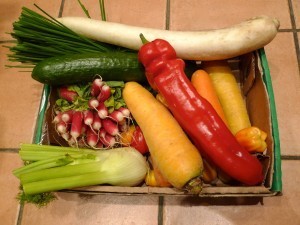
My palette of ingredients to play with
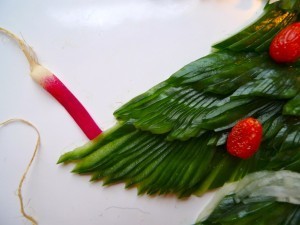
Detail of pine needles
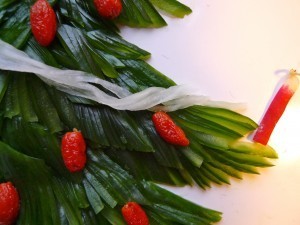
Detail of tinsel
Anyway, I’ve never attempted anything of the sort before, but thought it would be fun to try to make an edible Christmas tree in homage to this Chinese tradition. And after several hours of painstaking work last weekend, here you are! The Christmas tree is made from pieces of cucumber skin sliced into little fans; the tree trunk and tub from soaked dried shiitake mushrooms, with a red ribbon made from a red pepper; the baubles are gouqi berries; the star is two slices of different-coloured carrots; and the tinsel from very fine shreds of white radish, twined together. My favourite detail is the candles, which are simply tiny pieces cut from little pink radishes, each of which came with its own little ‘plume of smoke’ in the form of the root!
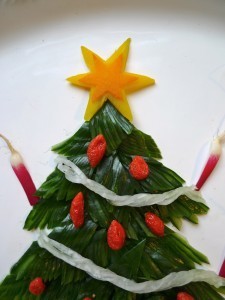
Detail of star
December 16, 2013
House of Ho
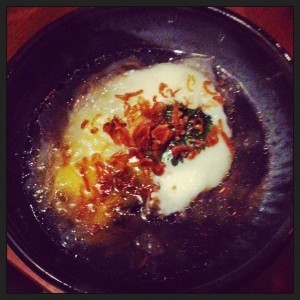
That marvellous egg pho cuon
A few years ago, I happened to be in an episode of Bobby Chinn’s World Cafe Asia when he was filming in Chengdu: you can watch our antics here (small fee required to watch the video). Anyway, turns out he’s opened a restaurant in London, and it was a lovely surprise to receive a phonecall out of the blue and an invitation to try some of the dishes at the House of Ho, opening this week in Soho, London…
The highlight was undoubtedly the Pho Cuon, a dreamy, ethereal parcel of rice pasta enclosing an egg cooked
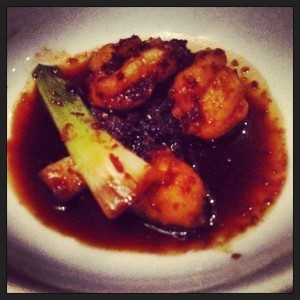
Monkfish with lemongrass
long and slow, in a very delicate broth, but we also loved the smokey aubergine with warm scallion vinaigrette, the shaking beef, the lemon grass monk fish in a caramel sauce, and the stir-fried egg choyote, which was very simple and utterly gorgeous.
House of Ho, 55-59 Old Compton Street, 0207 287 0770
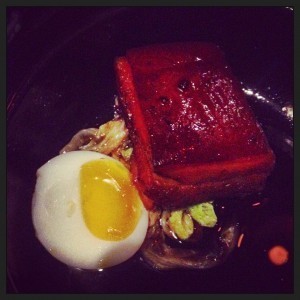
Apple-smoked pork belly, braised cabbage, egg
December 3, 2013
Chinese feasts for the British PM – a few thoughts
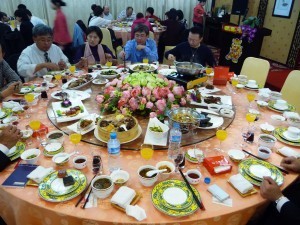
Random Chinese banquet picture from my library!
Today, the Daily Telegraph published menus of the lunch and dinner served to the British Prime Minister David Cameron yesterday in Beijing. Lunch, apparently, was ‘hors d’oeuvres’, creamy mushroom soup, beef steak Chinese style, bamboo fungus with green vegetables and boiled sea bass, followed by pumpkin cream with sago, ‘pastries’ and fruit. Dinner was another ‘hors d’oeuvres’, sturgeon’s marrow and bamboo fungus soup, boiled lobster claw with peach gum and saffron, codfish roll with bacon, sauteed shredded pork in chilli and garlic sauce, steamed duck and taro paste with rice wine, assorted vegetables in casserole and rice congee with gingko, followed by more ‘pastries’ and fruit.
It’s incredibly frustrating not to be able to see the Chinese names of the dishes, which must remain vague. Do journalists reporting this summit really have better things to do than provide adequate news about the catering?!! I called the Downing Street press office to ask if they had a copy of the full menu, but they didn’t. It’s too late to call Beijing, and a certain amount of Googling in both English and Chinese isn’t throwing up much more information, so we will have to guess…
LUNCH
The ‘hors d’oeuvres’ must remain a mystery, but presumably included several pretty and delicious appetisers. It looks as though the lunch was a simple affair, designed to be accessible and easy: a case, perhaps, of ‘Western food with Chinese characteristics’ or ‘Chinese food with Western characteristics. A mushroom soup (really made with cream? or just with a rich, dense Chinese stock 浓汤?); beef steak, traditionally loved more by Westerners than Chinese but rapidly gaining currency in modern China; and some kind of green vegetable, but accompanied by lacy, ethereal bamboo pith fungus 竹荪.
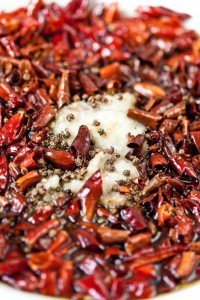
Did they really serve this fiery dish to David Cameron?
The ‘boiled sea bass’ is a little ambiguous: it sounds like ‘water-boiled sea bass’ 水煮鲈鱼 , that dazzling Sichuanese dish of slippery poached fish in a sea of sizzling chilli oil, but official banquets for foreigners normally steer clear of radically spicy dishes and food drowned in oil. Was this a nod to the new popularity of spicy Sichuanese food in London, or was it really a more delicate dish of poached sea bass, without the raucous, sweat-inducing chillies and riotous zing of Sichuan pepper? That might have been more diplomatically appropriate, if less exciting. It’s hard to tell from the translation.
The pumpkin cream was presumably a smooth, sweetened pumpkin soup all floaty with little sago pearls. I do wish they’d seen fit to elaborate about the pastries.
It appears that this lunch was a relatively modest affair, in keeping with Xi Jinping’s campaign against official extravagance and the waste of public funds. He has been urging officials to keep to the basic ‘four dishes and a soup’ 四菜一汤 rather than lavishing money on tables groaning with delicacies.
DINNER
The dinner appears to have been more of a banquet, even if it was nothing in comparison to the only official Chinese banquet I’ve attended, where twenty or thirty dishes were served (most of them untouched because all the guests were so busy rushing around raising toasts to each other!). A sign of the times! An austerity campaign and the eyes of the Chinese people peeled for the symptoms of official gluttony…
Again, the ‘hors d’oeuvres’ are not individually listed, which is a shame because they might have been rather interesting.
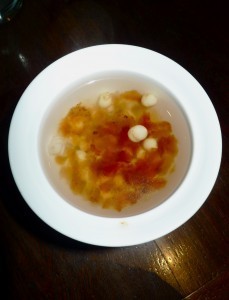
A delicate soup of honeyed peach sap and Job's tears
The first main course is something I’ve never tried: sturgeon’s bone marrow, known in Russian as vesiga and in Chinese, rather poetically, as the ‘dragon’s tendon’ of the fish 鲟鱼龙筋 , served with bamboo pith fungus in what one can imagine must have been a very refined banquet stock. The lobster claws are prepared with another lyrical, exotic Chinese ingredient, the sap of the peach tree 桃胶 , which I have been lucky enough to taste and which has always struck me as food fit for the immortals. (The saffron is a modernist touch: I think the only time I’ve really had it in Chinese dishes is at Da Dong in Beijing, where China’s most acclaimed celebrity chef, Dong Zhenxiang, uses it in his version of a traditional Shandong dish of Chinese cabbage with chestnuts.)
The codfish roll with bacon sounds like a new dish made with imported fish: cod has been appearing on the menus of more cosmopolitan restaurants in recent years. But it’s hard to speculate further without seeing the Chinese characters.
I’m guessing the sauteed shredded pork must be that Sichuanese classic fish-fragrant pork slivers 鱼香肉丝, which is not only divinely delicious, but only mildly spicy from the pickled chillies, which makes it the kind of Sichuan dish traditionally considered suitable for high-level banquets. I’m not sure about the steamed duck and taro paste with rice wine.
If anyone has a copy of the Chinese menu, please let me know!
November 2, 2013
Strange fruits
 These extraordinary wild fruits, harvested in the Zhejiang countryside, taste rather like pear or jujube, although of course they have proportionally less flesh to skin, to the skin seems thicker and more fibrous. The seeds form outside the fleshy fruit, as you can see in the pictures. Their Latin name is Hovenia Acerbis Lindl, which may be the same as Hovenia Dulcis, the oriental raising tree – see this Wikipedia entry. In Chinese, they
These extraordinary wild fruits, harvested in the Zhejiang countryside, taste rather like pear or jujube, although of course they have proportionally less flesh to skin, to the skin seems thicker and more fibrous. The seeds form outside the fleshy fruit, as you can see in the pictures. Their Latin name is Hovenia Acerbis Lindl, which may be the same as Hovenia Dulcis, the oriental raising tree – see this Wikipedia entry. In Chinese, they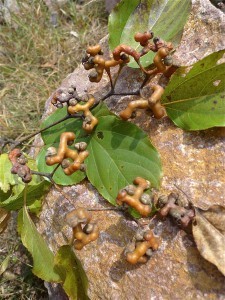 are called guai zao(拐枣), whose literal translation is apposite and charming: jujubes turning corners! A perfect description of their sweet, jujube-like flavour and strange, angular construction. I think they look like dancing horses or underfloor plumbing. According to Wikipedia, they taste like raisins when dried.
are called guai zao(拐枣), whose literal translation is apposite and charming: jujubes turning corners! A perfect description of their sweet, jujube-like flavour and strange, angular construction. I think they look like dancing horses or underfloor plumbing. According to Wikipedia, they taste like raisins when dried.
October 10, 2013
Translation – any ideas?!
A friend of mine who is a big cheese in Chinese food circles (or should we say ‘a big tofu’ in these parts?) has asked me for ideas in translating his Chinese term shi xue 食学 (literally ‘Food Studies’). He is proposing that there should be an academic discipline of this name on with the same status as subjects like chemistry, geography and history. It will encompass ecology; food production from farm to plate (including agriculture, animal husbandry, hunting, fishing, foraging…); cookery; gastronomy; the aesthetics of food; the biological process of eating from mastication through digestion to excretion; food law; nutrition; diet-related diseases; famine and other food disasters; anthropology of food; food education; and so on.
We discussed the literal translation ‘Food Studies’, but he doesn’t think it sounds weighty enough, and would like a snappy one-word term, perhaps a new one. we talked about Foodology and Eatology – but they sound too frivolous. Gastronomy seems focused too much on the pleasures of eating. Gastrography? Is their an existing term that I’m missing that would be more suitable?
Anyway, if there are any imaginative linguists out there who have bright ideas, please let me know and I will pass them on!
Thanks in advance for any inspirations.
Fuchsia Dunlop's Blog
- Fuchsia Dunlop's profile
- 392 followers


